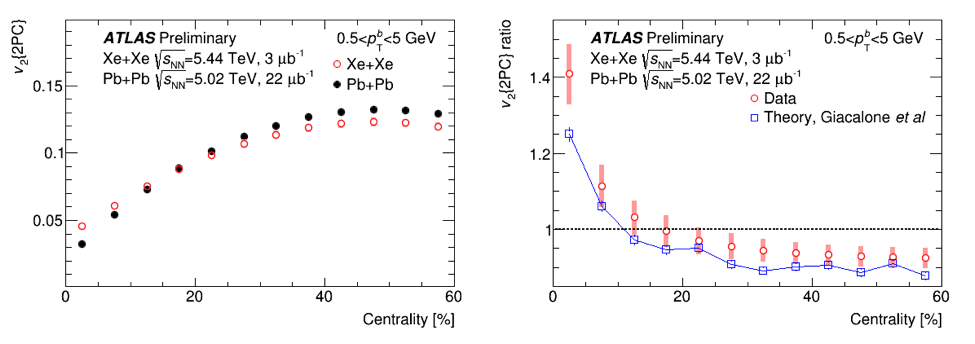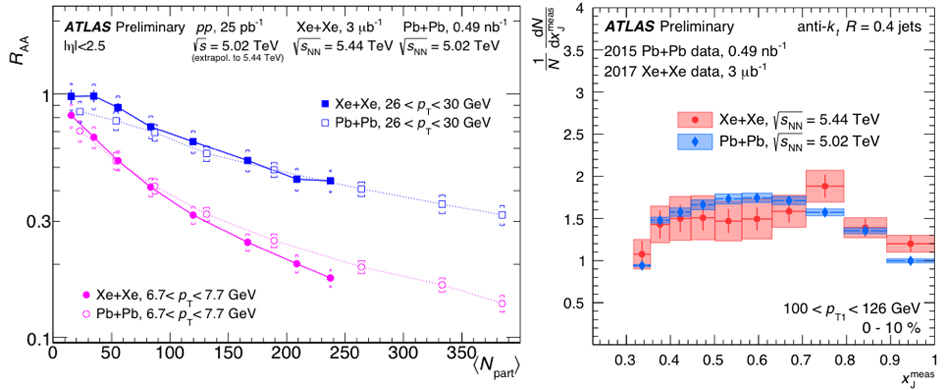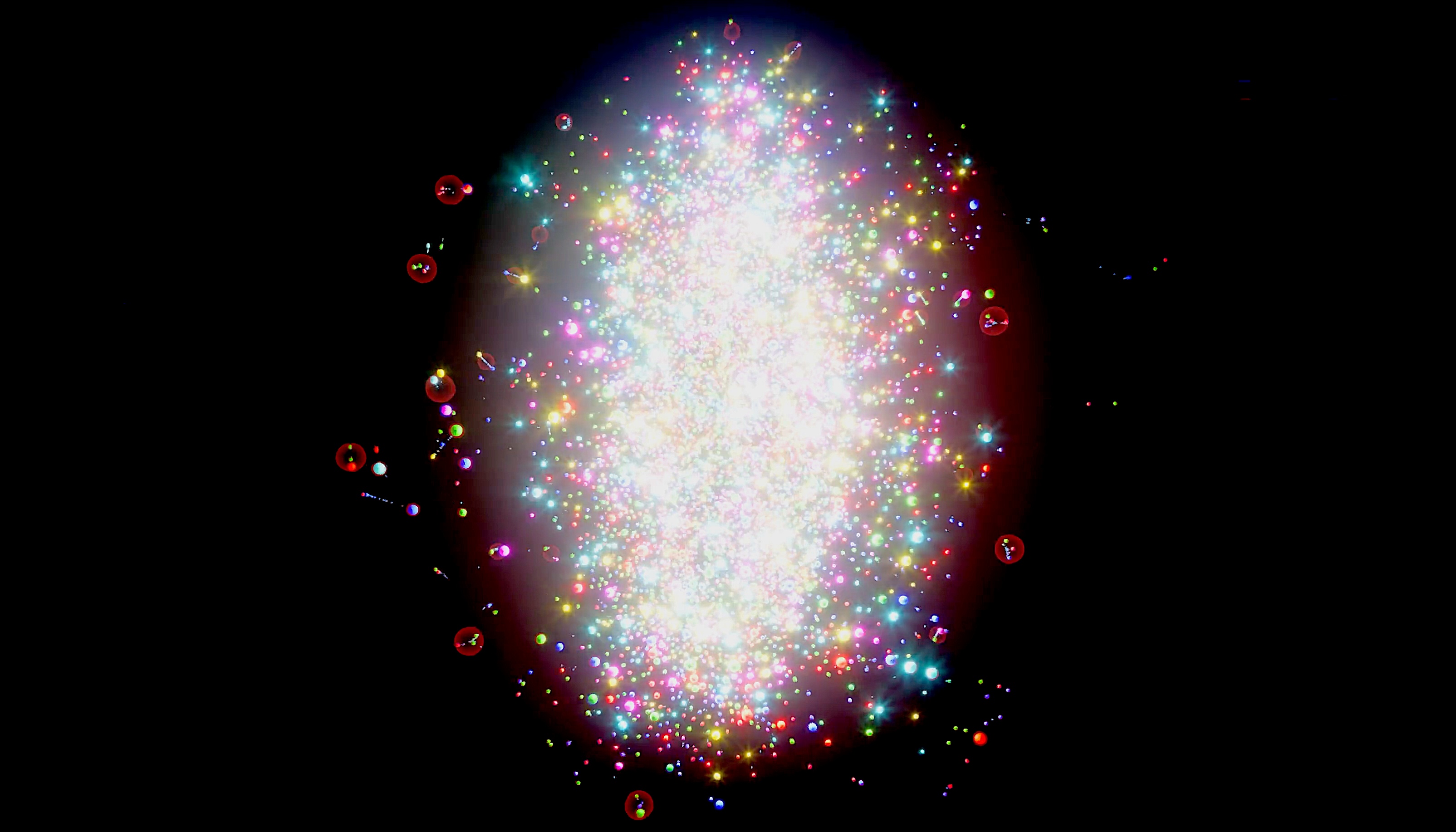Noble collisions give new insights on heavy ion systems
24 May 2018 | By

In October 2017, the ATLAS experiment recorded collisions of xenon nuclei for the first time. While massive compared to a proton, xenon nuclei are smaller than the lead ions typically collided in the LHC (129 nucleons compared to 208 nucleons and a nuclear radii of 5.4 femtometre (10-15 m) compared to 6.6 fm). The xenon-xenon collision data, combined with previous results from the analysis of lead-lead collisions, provide the first opportunity to examine heavy ion collisions in a system that is distinctly smaller in size. This allows physicists to study in detail the role of the collision geometry for observables often associated with the quark-gluon plasma (QGP).
In new results presented at the recent Quark Matter 2018 conference, ATLAS has studied “collective flow” and “jet quenching” in both xenon-xenon and lead-lead collisions. The measurements are performed as a function of “centrality”, which characterizes the amount of overlap between the nuclei and the number of nucleons participating in the collision. Collisions of low centrality percentile (“central”) have larger overlap and a large number of nucleons (Npart), while those with large percentile (“peripheral”) have smaller overlap and a small Npart.
How geometry shapes collisions
"Collective flow” refers to the fact that in heavy ion collisions, the hot and dense matter responds like a subatomic fluid droplet, converting the shape of the nuclear overlap region in each collision into distinct patterns in the outgoing angles of the produced particles. Typically, the “elliptic” modulation is most prominent and its relative amplitude, v2, is useful for quantifying the collectivity of the QGP.
Comparisons of elliptic flow measurements in xenon-xenon and lead-lead collisions provide a unique opportunity to study viscous effects in the hydrodynamic expansion of the QGP, as well as the effects of event-by-event fluctuations in the collision geometry. These fluctuations are generally expected to be larger in xenon collisions than in those of lead ions, and to amplify the spatial deformations in the initial shape of the overlap region, thus enhancing the observed flow. This increase is offset by viscous effects which are expected to weaken the amplitude of flow in non-central collisions, and even more so in xenon collisions where the spatial variations are larger.
Figure 1 compares the centrality dependence of the charged particle’s v2 in xenon-xenon and lead-lead collisions. The v2 observed in the xenon data is ~40% larger than that seen in the most central lead-lead collisions. However, for more peripheral collisions, the difference reverses, with xenon v2 becoming smaller than in lead-lead collisions. These results follow the basic expectations described above. They are also qualitatively reproduced by theory calculations shown in the right panel of Figure 1. Clearly, even a straightforward incorporation of the different shapes of lead-lead and xenon-xenon collisions is enough to understand these data.

Observations quench curiosity
The differences between the size and fluctuations of the overlap region can also be explored by its impact on jets produced in the initial collisions of nucleons in the nuclei. High energy quarks and gluons (“partons”) produced in hard-scattering processes in heavy ion collisions loose energy due to their interactions with the QGP – an effect called “jet quenching”. The quenching may be weakened in xenon-xenon collisions relative to lead-lead collisions due to the reduced density of the QGP and the smaller path lengths of the partons in the plasma. Generally, the parton energy loss reduces the yield of high-momentum particles stemming from the fragmentation of jets into a collimated spray of hadrons. The reduction is quantified by RAA, the ratio of particle yields as a function of transverse momentum in nuclear collisions to that in proton-proton collisions, scaled by a factor that accounts for the flux of colliding quarks and gluons from each nucleus, which reflects the geometric overlap of the two nuclei.
The charged hadron RAA measured in xenon-xenon and lead-lead collisions are compared in Figure 2 as a function of the number of nucleons, the number of participating nucleons estimated using the transverse energy measured in the ATLAS forward calorimeter. The RAA values are always less than unity due to the suppression of high-momentum hadrons induced by jet quenching. The xenon and lead results are similar, but slightly more suppression is observed in the xenon collisions, suggesting that the overlap geometry is not the only feature which determines the precise amount of jet quenching.
Jet quenching can also induce an imbalance between pairs of jets, which are typically produced back-to-back with equal transverse momentum in the initial scattering of two partons. The two jets may travel different distances in the plasma and thus lose different amounts of energy. ATLAS physicists can examine this imbalance by calculating the ratio of the transverse momentum of the lower-momentum jet to that of the higher-momentum jet, with an observable called xj. The distributions of dijet xj are shown in the right panel of Figure 2 for xenon and lead collisions and are consistent within uncertainties. This similarity is striking given the expected weakening of the quenching in the smaller xenon-xenon collisions.
Expanding the heavy ion landscape
These are only the first results from this small, but very interesting, xenon collision dataset. They demonstrate the flexibility of both the LHC and ATLAS for studying a broad landscape of heavy ion collision systems, and point to further interesting results from future comparisons of smaller and larger systems.
Links:
- Quark Matter 2018 presentation by Petr Balek: Charged particle suppression in Pb+Pb, Xe+Xe, and p+Pb collisions measured with the ATLAS detector.
- Quark Matter 2018 presentation by Martin Spousta: Measurements of inclusive jet suppression, azimuthal dependence of jet yields, and jet substructure at 5.02 TeV with ATLAS.
- Hydrodynamic predictions for 5.44 TeV Xe+Xe collisions, G. Giacalone, J. Noronha-Hostler, M. Luzum and J. Y. Ollitrault, (arXiv: 1711.08499)
- See also the full lists of ATLAS Conference Notes and ATLAS Physics Papers.


